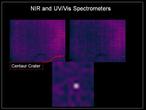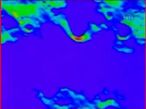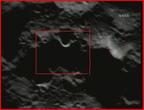Observing to the last second
LCROSS Crashes on the Moon
The LCROSS mission ended today with two controlled impacts into the crater Cabeus on the south pole of the Moon. First the upper stage rocket Centaur with a mass of over 5000 pounds hit the Moon. The impact created a big dust cloud, which was analyzed when LCROSS itself came down through the cloud to find its end in the same location.
Through the impact of Centaur a crater of around 70 feet in diameter and 18 feet deep was created. The scientists estimated that the crash flung up 400 tons of dust and loose rocks (see animation).
LCROSS followed close behind and flew through the cloud of material with all its sensors working to perfection. In fact LCROSS crashed only four minutes after Centaur. The astronomers gained important data from which they hope to learn more about the composition of the Moon. Specifically the scientists are looking for water. Already earlier measurements of the Japanese probe Kaguya showed high concentration of hydrogen in the crater, which opens the possibility of the existence of water ice.
The impact of LCROSS itself just created a small crater about four minutes and lots of data gathering later. Many earthbound telescopes of professional and amateur astronomers observed the impacts on the southern "edge" of the Moon. NASA TV broadcast the event live. They expected a cloud up to 4 miles high and casts a shadow all the way to the other side of the crater.
Redshift-live will continue its updates as more information becomes available.
Source: NASA
LCROSS followed close behind and flew through the cloud of material with all its sensors working to perfection. In fact LCROSS crashed only four minutes after Centaur. The astronomers gained important data from which they hope to learn more about the composition of the Moon. Specifically the scientists are looking for water. Already earlier measurements of the Japanese probe Kaguya showed high concentration of hydrogen in the crater, which opens the possibility of the existence of water ice.
The impact of LCROSS itself just created a small crater about four minutes and lots of data gathering later. Many earthbound telescopes of professional and amateur astronomers observed the impacts on the southern "edge" of the Moon. NASA TV broadcast the event live. They expected a cloud up to 4 miles high and casts a shadow all the way to the other side of the crater.
Redshift-live will continue its updates as more information becomes available.
Source: NASA
Observing to the last second
LCROSS Crashes on the Moon
The LCROSS mission ended today with two controlled impacts into the crater Cabeus on the south pole of the Moon. First the upper stage rocket Centaur with a mass of over 5000 pounds hit the Moon. The impact created a big dust cloud, which was analyzed when LCROSS itself came down through the cloud to find its end in the same location.
Through the impact of Centaur a crater of around 70 feet in diameter and 18 feet deep was created. The scientists estimated that the crash flung up 400 tons of dust and loose rocks (see animation).
LCROSS followed close behind and flew through the cloud of material with all its sensors working to perfection. In fact LCROSS crashed only four minutes after Centaur. The astronomers gained important data from which they hope to learn more about the composition of the Moon. Specifically the scientists are looking for water. Already earlier measurements of the Japanese probe Kaguya showed high concentration of hydrogen in the crater, which opens the possibility of the existence of water ice.
The impact of LCROSS itself just created a small crater about four minutes and lots of data gathering later. Many earthbound telescopes of professional and amateur astronomers observed the impacts on the southern "edge" of the Moon. NASA TV broadcast the event live. They expected a cloud up to 4 miles high and casts a shadow all the way to the other side of the crater.
Redshift-live will continue its updates as more information becomes available.
Source: NASA
LCROSS followed close behind and flew through the cloud of material with all its sensors working to perfection. In fact LCROSS crashed only four minutes after Centaur. The astronomers gained important data from which they hope to learn more about the composition of the Moon. Specifically the scientists are looking for water. Already earlier measurements of the Japanese probe Kaguya showed high concentration of hydrogen in the crater, which opens the possibility of the existence of water ice.
The impact of LCROSS itself just created a small crater about four minutes and lots of data gathering later. Many earthbound telescopes of professional and amateur astronomers observed the impacts on the southern "edge" of the Moon. NASA TV broadcast the event live. They expected a cloud up to 4 miles high and casts a shadow all the way to the other side of the crater.
Redshift-live will continue its updates as more information becomes available.
Source: NASA








